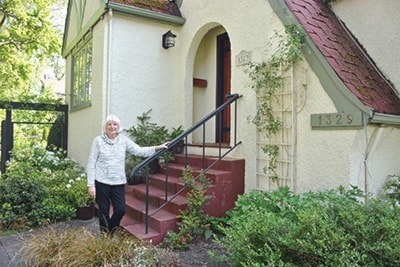It’s been said that the greenest house is the one already built.
And the message to homeowners – or prospective buyers – of Oak Bay’s older homes is that they can often be renovated to adapt to today’s lifestyles while still retaining the charm and community benefit, says Pat Wilson, who leads the registration/designation process for Oak Bay Heritage.
“Placing your home on the heritage register (says) your home has heritage value to the community,” says Wilson, who with her husband, Brian McKinnell, is also in the process of having their home included on Oak Bay’s Heritage Register.
Having lived in their home for 18 years, renovations over that time have created an interior space that suits today’s lifestyle, while retaining the character of the home’s exterior for all to enjoy.
Built in 1939 as an infill property on the tennis court of a neighbouring house, the Coltswold-style 1 1/2-storey cottage with asymmetrical cross-gabled steeply pitched roof is tucked into a larger lot surrounded by gardens.
“The house is a good example of the ‘storybook’ homes built for middle-class families moving to the suburbs in the decades following World War 1, a time of traditionalism and picturesque home building,” explains the information submitted for the registry, noting the popularity of this architectural style began to wane with the arrival of the Second World War.
“The building style expressed a romantic, cozy, domestic ideal based on efficent smaller houses that recognized the economic constraints and reality that most families had to manage without domestic help. The basement entry garage reflected the increased importance and proliferation of the automobile.”
The Oak Bay Community Heritage Register is an official list of buildings and sites deemed of heritage value or character, as adopted by resolution of council. Register buildings are incorporated into the Heritage Building Inventory.
Inclusion of a property on the Heritage Register is voluntary and does not offer heritage protection, nor is it a formal designation. While no legal requirements accompany heritage register it does recognize the home’s significance, Wilson says.
In addition to their architectural value, Oak Bay’s older homes also speak to the municipality’s streetscapes and social history.
“Putting it on the register, you’re allowing council to use it as a planning tool,” Wilson says, estimating the register currently includes about 75 homes.
“It flags your home as having heritage value and celebrating what is good about your home for the rest of us.”
Having your home included on the heritage register is as simple as submitting a letter expressing interest, Wilson says. There’s no cost to the homeowners and volunteer researchers then explore the history of the home, before it’s sent to council for approval.
“Most homeowners find it very interesting,” says Wilson, an accountant by training, who enjoys the research.
“I personally love the old houses and love Oak Bay,” she says.
Down the road, register placement also makes it easier if homeowners opt to seek official heritage designation.
“The advantage to us is if you do want to designate, 80 per cent of the work is done,” Wilson says. “It’s an easy transition from the register to designation which you can do to get grants.”
